+91-512-259-7629
+91-512-259-7629
Highlighted are some of the recent publications that have emerged from our department, showcasing our commitment to advancing user-centric research and design. These publications represent just a glimpse of the impactful work happening in the ChE department.
Abstract:
Driven by the necessity to achieve a thorough comprehension of the bottom-up fabrication process of functional materials, this experimental study investigates the pairwise interactions or collisions between chemically active SiO2–Pt Janus colloids. These collisions are categorized based on the Janus colloids’ orientations before and after they make physical contact. In addition to the hydrodynamic interactions, the Janus colloids are also known to affect each other’s chemical field, resulting in chemophoretic interactions, which depend on the degree of surface anisotropy in reactivity of Janus colloid and the solute–surface interaction at play. Our study reveals that these interactions lead to a noticeable decrease in particle speed and changes in orientation that correlate with the contact duration and yield different collision types. Distinct configurations of contact during collisions were found, whose mechanisms and likelihood are found to be dependent primarily on the chemical interactions. Such estimates of collision and their characterization in dilute suspensions shall have a key impact in determining the arrangement and time scales of dynamical structures and assemblies of denser suspensions and potentially the functional materials of the future.

Abstract: It has been recently shown that it is possible to design simple artificial swimmers at low Reynolds number that possess only one degree of freedom and, nevertheless, can overcome Purcell’s celebrated scallop theorem. One of the few examples is given by Montino and DeSimone, Eur. Phys. J. E, vol. 38, 2015, who consider the three-sphere Swimmer of Najafi and Golestanian, replacing one active arm with a passive elastic spring. We further generalize this idea by increasing the number of springs and show that it is possible to invert the swimming direction using the frequency of the single actuated arm.
Read More ...
Abstract:Sensitive yet stable, robust yet flexible and accurate yet energy efficient pressure sensors are required for variety of purposes. While a large variety of designs and dielectric materials have been explored for this purpose, there is still need of a flexible pressure sensor that will allow easy scale up and inexpensive fabrication. To this end, we have presented here the design of a flexible capacitive pressure sensor using copper coated paper as flexible electrodes and soft Ecoflex layers decorated with cylindrical micro-pillars as the dielectric. While microscopic construct of the sensor allows its easy manufacturability, softness of the layer imparts sensitivity to it. In contrast to many conventional sensors, this design yields sensitivity as high as ∼5 kPa−1 at pressure <1 kPa and somewhat smaller sensitivity as pressure exceeds 1 kPa. We have varied systematically pillar diameter, skin thickness of dielectric layer and pitch of the pillar array to optimise the design and demonstrate its easy tunability. We have presented a model based on buckling of the pillars to predict the response of the sensor. We have explored also a specific design that minimises the hysteresis.
Read More ...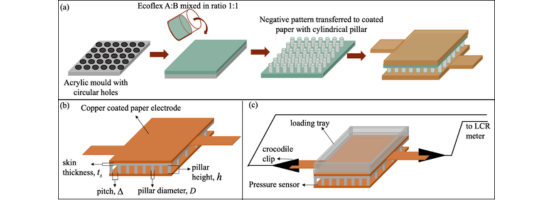
Abstract:In tissue engineering, the pivotal role of scaffolds is underscored, serving as key elements to emulate the native extracellular matrix. These scaffolds must provide structural integrity and support and supply electrical, mechanical, and chemical cues for cell and tissue growth. Notably, electrical conductivity plays a crucial role when dealing with tissues like bone, spinal, neural, and cardiac tissues. However, the typical materials used as tissue engineering scaffolds are predominantly polymers, which generally characteristically feature poor electrical conductivity. Therefore, it is often necessary to incorporate conductive materials into the polymeric matrix to yield electrically conductive scaffolds and further enable electrical stimulation. Among different conductive materials, carbon nanomaterials have attracted significant attention in developing conductive tissue engineering scaffolds, demonstrating excellent biocompatibility and bioactivity in both in vitro and in vivo settings. This article aims to comprehensively review the current landscape of carbon-based conductive scaffolds, with a specific focus on their role in advancing tissue engineering for the regeneration and maturation of functional tissues, emphasizing the application of electrical stimulation. This review highlights the versatility of carbon-based conductive scaffolds and addresses existing challenges and prospects, shedding light on the trajectory of innovative conductive scaffold development in tissue engineering.
Read More ...
Abstract: Polydimethylsiloxane (PDMS) is known to be a common substrate for various cell culture-based applications. However, native PDMS is not very conducive for cell culture and hence, surface modification via cell adhesion moieties is generally needed to make it suitable especially for long-term cell culture. To address this issue, we propose to coat PDMS nanoparticles (NPs) on the surface of PDMS film to improve adhesion, proliferation and differentiation of skin cells. The proposed modification strategy introduces necessary nanotopography without altering the surface chemical properties of PDMS. Due to resemblance in the mechanical properties of PDMS with skin, PDMS NPs can recreate the native extracellular nanoenvironment of skin on the PDMS surface and provide anchoring sites for skin cells to adhere and grow. Human keratinocytes, representing 95% of the epidermal skin cells maintained their …
Read More ...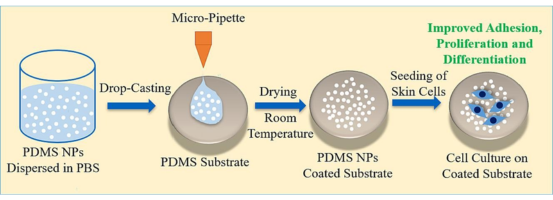
Abstract: The production of commercially important rare-earth elements in significant proportions also leads to the problem of industrial effluents containing metal oxides, cyanides, etc. generated from mining, mineral processing, and metallurgical operations. In the current work, ultrasound (US)-based methods are used for treatment of commercially obtained effluent from rare-earth metal processing industry containing ammonium thiocyanate (NH4SCN) as a major target contaminant. The effect of operating parameters as pH (actual values as 1, 3, 7, 9, 12), H2O2 loading (800 to 1400 ppm), O3 flow rate (0.5 to 2 L/min), and catalyst type (TiO2 or MnO2 at fixed loading of 1 g/L) on the efficacy of treatment was studied. The treatment of effluent using the approaches of US and ozone (flow rate as 0.5 L/min) alone under the constant conditions of 120 W and 70% duty cycle showed no chemical oxidation demand (COD) reduction …
Read More ...
Abstract:Metal oxide porous nanomaterials are of great interest across scientific fields due to their intriguing properties, allowing their usage from lab-scale research to industrial applications. However, the production of high surface area metal oxide nanomaterials still poses significant challenges. This study introduces a novel method for synthesizing highly porous tin oxide (SnO2) nanostructures using carbon as the template material. The synthesis process includes the formation of a precursor composite containing resorcinol-formaldehyde gel and a tin oxide precursor, which is first carbonized to convert the resorcinol-formaldehyde into a porous three-dimensional carbon framework. This framework acts as a scaffold for the nucleation of SnO2 nanoparticles. Subsequent oxidation selectively removes the carbon template, yielding highly porous SnO2 nanomaterials. Electron microscopy analysis shows that the …
Read More ...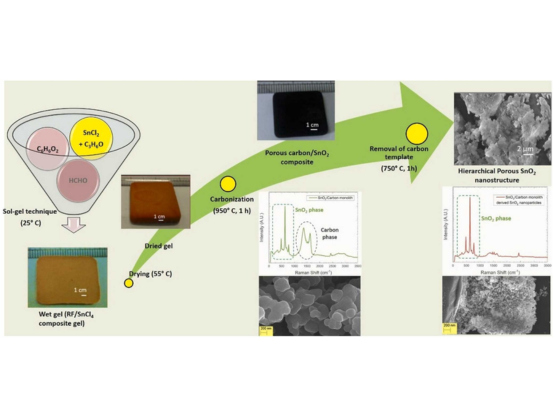
Abstract:Electrified sessile droplets on solid surfaces are ubiquitous in nature as well as in several practical applications. Although the influence of electric field on pinned sessile droplets and soap bubbles has been investigated experimentally, the theoretical understanding of the stability limit of generic droplets remains largely elusive. By conducting a theoretical analysis in the framework of lubrication approximation, we show that the stability limit of a sessile droplet on a lyophilic substrate in the presence of an electric field exhibits a universal power-law scaling behavior. The power-law exponent between the critical electric field and the droplet volume is found to be− 1. The existence of this scaling law is further explained by virtue of minimization of the total free energy of the electrified droplet.
Read More ...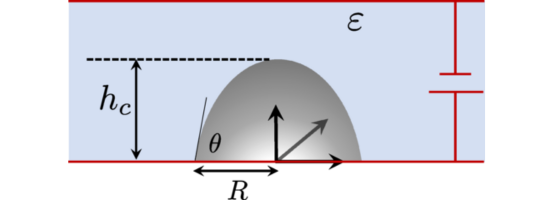
Abstract:A series of Al2O3-supported bimetallic Ni-Fe catalyst with Ni/Fe = 3 are prepared, characterized, and examined for CO2 methanation to identify the total metal loading (Ni+Fe) that yields the maximum activity. The XRD patterns of all catalysts exhibit a noticeable peak shift, which suggests alloy formation and XPS studies reveal that the near-surface concentration of the reduced catalysts possess Ni/Fe ratios similar to those targeted. Analysis of the particle size distribution from TEM and degree of reduction from TPR clearly shows that an increase in metal loading results in a gradual decrease in effective dispersion. However, the catalyst with 55% total metal loading of Ni+Fe, 55Ni3FeAl, possessed the maximum surface metal sites and effective surface metal area, which is reflected in the highest activity of this catalyst during CO2 methanation. Kinetic measurements of the CO2 methanation reaction are obtained on …
Read More ...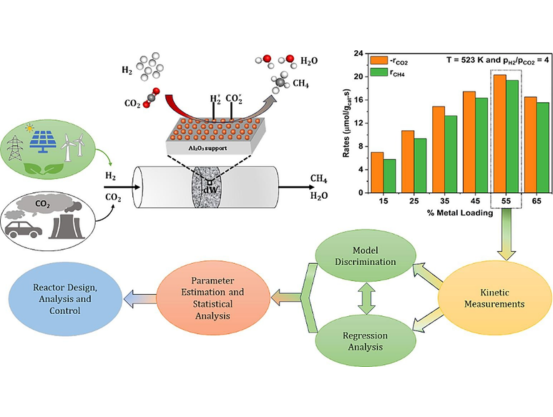
Abstract:Zirconia supported vanadium oxide (vanadia) and chromium oxide (chromia) catalysts of 1 to 3 wt.% of V or Cr were prepared, characterized, and tested for the oxidative dehydrogenation (ODH) of propane (C3H8) with O2 and CO2. Characterization results reveal that 2.5% metal loading is in slight excess of monolayer loadings for this ZrO2, which has a surface area of 48 m2.g-1. The reaction results reveal that supported vanadia catalysts are better for O2-ODH and supported chromia catalyst are better for CO2-ODH at a reaction temperature of 550 oC. Furthermore, the C3H8 conversion and propene (C3H6) yield increases with loading and the highest conversion and yield are also achieved at 2.5% metal loading. With higher loadings the conversion and yield decreases, clearly indicating that the surface metal oxide species are more active than their crystalline counterparts. As the contact time increases, for inlet …
Read More ...
Abstract: Supported molybdenum oxides have been widely employed as catalysts for variety of reactions including upgrading of bio-oil via hydrodeoxygenation. Herein, we perform spin-polarized density functional theory calculations to investigate the structures and reactivity of monomeric MoO x species supported on ZrO 2 in the absence and presence of hydroxyl (s). Monomeric molybdenum moieties were found to have a mono-oxo (one molybdenyl), di-oxo (two molybdenyls) or a pero-oxo (one molybdenyl and Mo coordinated to a peroxide) configuration. Based on the formation energies, we find that mono-oxo moieties are the most stable among the three. This is also true for the moieties in the presence of hydroxyls on the support. Further, the computed vibrational frequencies of a mono-oxo moiety on a hydroxylated support is a closer match to the peaks observed in experiments. A thermodynamic analysis of the …
Read More ...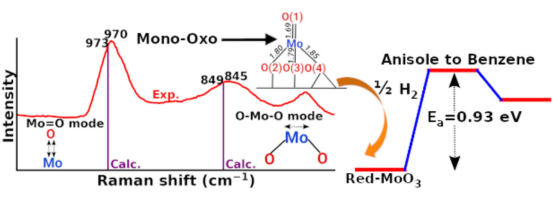
Abstract:Incomplete structural details of Mycobacterium tuberculosis (Mtb) fatty acid synthase-I (FAS-I) at near-atomic resolution have limited our understanding of the shuttling mechanism of its mobile acyl carrier protein (ACP). Here, we have performed atomistic molecular dynamics simulation of Mtb FAS-I with a homology-modeled structure of ACP stalled at dehydratase (DH) and identified key residues that mediate anchoring of the recognition helix of ACP near DH. The observed distance between catalytic residues of ACP and DH agrees with that reported for fungal FAS-I. Further, the conformation of the peripheral linker is found to be crucial in stabilizing ACP near DH. Correlated interdomain motion is observed between DH, enoyl reductase, and malonyl/palmitoyl transferase, consistent with prior experimental reports of fungal and Mtb FAS-I.
Read More ...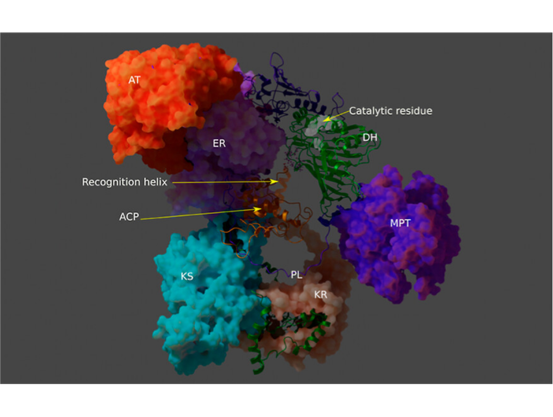
Abstract:We propose a computational framework to systematically identify promising solid–gas reaction candidates for thermochemical energy storage (TCES) in concentrating solar power (CSP) plants. The framework is based on four steps that include the generation of reaction candidates, screening based on thermodynamic criteria, solving a process model to estimate the levelized cost of electricity (LCOE) and thermal energy storage (TES) costs, and selection of the promising reactions. Our approach identifies twelve reactions from a pool of three hundred and sixty-four possible reactions. Furthermore, we develop an optimization model to simultaneously optimize the material properties, design, and operating conditions while considering the limitations on thermodynamic properties and the correlation between different material properties. The solution of the model yields a target (best possible) LCOE for a range of material prices. By comparing the LCOE of the systems employing the top-performing materials with the target LCOE, we discover that the LCOE of the systems is 9.7% to 15.9% higher than the target LCOE. Finally, we provide insights into the desired material properties to attain the target LCOE.
Read More ...
Abstract:Cryogenic distillation, a currently employed method for C2H4/C2H6 and C3H6/C3H8 mixture separation, is energy-intensive, prompting the research toward alternative technologies, including adsorbent-based separation. In this work, we combine machine learning (ML) technique with high-throughput screening to screen ∼23,000 hypothetical metal–organic frameworks (MOFs) for paraffin (C2H6 and C3H8) selective adsorbent separation. First, structure-based prescreening was employed to remove MOFs with undesired geometric properties. Further, a random forest model built upon the multicomponent grand canonical Monte Carlo (m-GCMC) simulation data of training set MOFs was found to be the most successful in learning the relationship between MOF features and olefin/paraffin mixture separation. Using this technique, the separation performance of the remaining (test set) MOFs was predicted, and the top-performing MOFs were identified. We also employed active learning (AL) to evaluate its effectiveness in improving the prediction of olefin/paraffin selectivity. AL was discovered to be ∼29 times more efficient than the best-supervised ML model, as it was able to identify the top materials in limited training data and at a fraction of computational cost and time as compared to ML techniques. Among the top selected materials, framework chemistry was found to be the most important parameter. Nickel and copper (as a metal node) in a tfzd and hms topological arrangement respectively, were discovered to be a prevalent attribute in high-performing MOFs, further demonstrating the prominent significance of framework chemistry. Additionally, the top MOFs discovered were studied in detail and further compared to the previously reported MOFs. These MOFs show the highest selectivity for C2H4/C2H6 and C3H6/C3H8 mixture separation, as reported until date. The hierarchical strategy devised in this study will facilitate the quick screening of MOFs across multiple databases toward industrially significant separation processes by leveraging molecular simulations and AL.
Read More ...
Abstract: Rising global energy demand, accompanied by environmental concerns linked to conventional fossil fuels, necessitates a shift toward cleaner and sustainable alternatives. This study focuses on the machine-learning (ML)-driven high-throughput screening of transition-metal (TM) atom intercalated g-C3N4/MX2 (M = Mo, W; X = S, Se, Te) heterostructures to unravel the rich landscape of possibilities for enhancing the hydrogen evolution reaction (HER) activity. The stability of the heterostructures and the intercalation within the substrates are verified through adhesion and binding energies, showcasing the significant impact of chalcogenide selection on the interaction properties. Based on hydrogen adsorption Gibbs free energy (ΔGH) computed via density functional theory (DFT) calculations, several ML models were evaluated, particularly random forest regression (RFR) emerges as a robust tool in predicting HER activity with a low mean absolute error (MAE) of 0.118 eV, thereby paving the way for accelerated catalyst screening. The Shapley Additive exPlanation (SHAP) analysis elucidates pivotal descriptors that influence the HER activity, including hydrogen adsorption on the C site (HC), MX layer (HMX), S site (HS), and intercalation of TM atoms at the N site (IN). Overall, our integrated approach utilizing DFT and ML effectively identifies hydrogen adsorption on the N site (site-3) of g-C3N4 as a pivotal active site, showcasing exceptional HER activity in heterostructures intercalated with Sc and Ti, underscoring their potential for advancing catalytic performance.
Read More ...
Abstract:The Taylor-Aris theory of shear diffusion predicts that the effective diffusivity of a tracer molecule in a sheared liquid is enhanced by a term quadratic in the shear rate. In sheared supercooled liquids, instead, the observed enhancement is linear in the shear rate. This is a fundamental observation for the physics of nonequilibrium liquids for which no theory or fundamental understanding is available. We derive a formula for the effective molecular diffusivity in supercooled liquids under shear flow based on the underlying Smoluchowski equation with shear (Smoluchowski diffusion-convection equation) with an energy barrier representing a crowded energy landscape. The obtained formula correctly recovers the effective diffusivity with a correction term linear in the shear rate, in agreement with results from numerical simulations of different liquids as well as with earlier experimental results on shear melting of colloidal glass. The theory predictions are supported by comparisons with molecular simulations of supercooled water and supercooled Lennard-Jones liquids, which confirm that the predicted enhancement of diffusivity is inversely proportional to temperature and directly proportional to the zero shear viscosity.
Read More ...
Abstract:A liquid film coating a cylindrical substrate is unstable to interfacial disturbances governed by Rayleigh-plateau instability. These initial disturbances grow in time and, beyond saturation, develop into a train of droplets of equal amplitude that move downstream at the same velocity. The traveling wave profiles, formed by a thermoviscous fluid as it flows down the exterior of a nonisothermal vertical cylinder, are computed as a function of various parameters. Further, this study investigates the stability behavior of these traveling waves. An unstable film leads to the formation of an axially asymmetric pattern. The influence of the thermoviscous nature of the fluid, along with the Biot number, Marangoni number, and Bond number, has been investigated. Linear stability analysis is performed by perturbing the axisymmetric traveling wave solution in the azimuthal direction. It is shown that while a gravity mode exists at small wave numbers, a thermocapillary mode exists at large wave numbers. The streamline patterns are shown to be consistent with the presence of the thermocapillary mode. The nonlinear analysis shows that the chosen pattern of instability does not correspond to the largest growth rate but is governed by the wavelength conforming to the periodic confinement in the azimuthal direction. An interesting pattern evolves in the presence of more than one such conforming wavelength.
Read More ...
Abstract: Desulfurization of thiol compounds, namely dibenzothiophene (DBT) and thiophene (TH) in n-octane was performed by combining the adsorptive and bacterial desulfurization techniques. Graphitic carbon nitride (g-C3N4) pellets were used as an adsorbent for thiol compounds as well as a substrate for the immobilization of bacterial endospores (ES) harvested from active bacterial cells.The integrated approach using ES_g-C3N4 showed an approximately 99% removal of both thiol compounds in 8 h at 30°C, attributed to the combined effects of adsorption by g-C3N4 and degradation by the ES-transformed bacteria. Bacterial identification and characterization were performed by the Gram and ES staining, SEM analysis, and 16S rRNA sequencing. Reusability test showed that the material could be used multiple times by washing and re-immobilizing it with ES. The spent liquid, subjected to 0.22 µm-syringe filtration, was declared free from bacterial cells. The integrated approach using ES_g-C3N4 is scalable, and can be used for the efficient desulfurization of liquid fuels.
Read More ...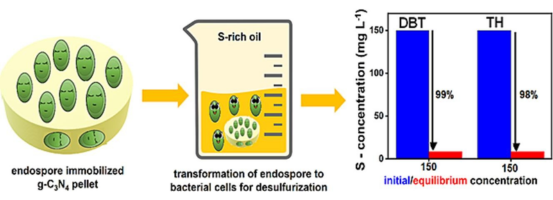
Abstract: Transition metals such as iron (Fe), molybdenum (Mo), copper (Cu), and zinc (Zn) at low concentrations are essential for plant growth and development. However, they may turn toxic beyond a threshold level. Therefore, a regulated supplement of these elemental micronutrients is important for achieving optimal effects on plant growth and nutritional quality. In the present study, we have developed a Fe–carbon nanofibers (CNF)-modified Mo-metal organic framework (MOF) that can release Fe–CNF and Mo upon microbial degradation in soil. CNF facilitates the translocation of Fe and Mo in plants. The synthesized Fe-CNF/Mo-MOF was characterized for physicochemical properties by applying a range of analytical techniques e.g., SEM-EDX, TEM, DLS, AAS, XRD, FTIR, and XPS. A gradual degradation of the Mo-MOF was observed in soil for 30 days, using scanning and transmission electron microscopy and Raman spectroscopy. Plant growth studies were performed using Cicer arietinum as a model plant. Our results showed that supplementing a low dose (0.22 g kg−1 soil) of Fe-CNF/Mo-MOF to soil was sufficient for the metals to reach plants, which subsequently improved plant growth (indicated by increased fresh biomass and root–shoot lengths) and nutritional quality (indicated by an increase in nitrogen, protein and chlorophyll contents). Although the present study is focused on the delivery of Fe and Mo, we believe that the developed material has a potentially broad applicability for supplementing the other mineral nutrients, including biomolecules.
Read More ...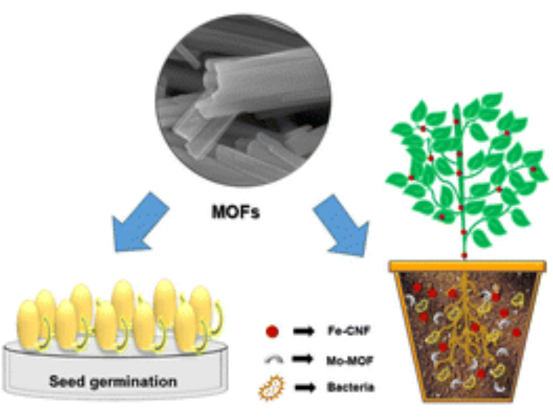
Abstract: Vanillin is the fragrant phenolic compound widely used as a food additive. However, an excessive consumption of vanillin can have adverse effects on human health. Therefore, the development of a sensor for the rapid and precise measurement of vanillin is essential. In this study, vanillin is successfully measured using the UV–Vis spectroelectrochemical (SEC) method. The method uses the laser induced graphene (LIG)-supported Cu nanoparticles coated over an indium tin oxide (ITO) as the electrode. The precursor material for Cu-LIG is synthesized using the suspension polymerization of phenol and formaldehyde, with the in-situ inclusion of Cu during gel formation step. The resulting polymeric film is subjected to calcination, hydrogen-reduction, and laser ablation to create a conductive Cu-LIG layer. The synthesized material exhibits a high electrochemical surface area of 0.907 cm2/cm2 and electrical conductance of 0.002 S, rendering it a suitable electrocatalyst for the oxidation of vanillin. The Cu-LIG/ITO electrode is used in detecting the oxidized species of vanillin at 370 nm-wavelength post two cyclic voltammetry (CV) cycles over 0–1.3 V potential. The sensor shows an excellent linear response (R2 value ∼ 0.993) over the concentration range 0.25–40 μg/mL, with 0.14 μg/mL limit of detection. Owing to the anti-interference ability of the SEC sensor, the intensity of UV–Vis absorbance at 370 nm remains unaffected against common interferents including glucose, fructose, ascorbic acid, and uric acid found in real food substances. This study has clearly shown the advantages of the combined electrochemistry and UV–Vis spectroscopy principles in quantitatively detecting oxidizable compounds in commercial food products.
Read More ...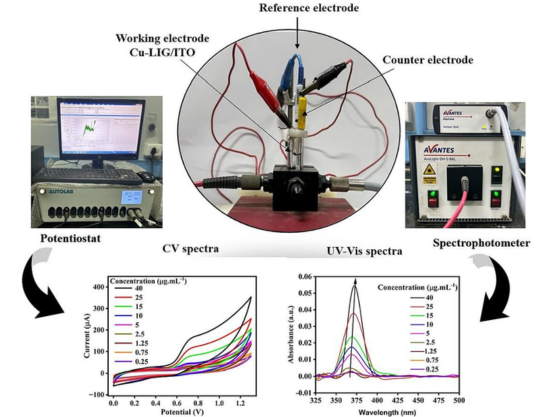
Abstract: This study presents a novel hybrid approach combining heterogeneous catalytic chemical reaction with biological intervention to denitrify wastewater. A graphitic carbon nitride (g-C3N4)-supported Ni-carbon nanofiber (CNF) is used as the catalyst, while Achromobacter denitirificans, isolated from an effluent of a sewage treatment plant, is used as the denitrifying bacteria. g-C3N4 acts as an artificial electron elicitor for biological regulation. Ni enhances the activity of key enzymes which are involved in bacterial denitrification, while the CNF surface immobilizes the bacteria. The catalyst and bacterial cells are characterized and identified using spectroscopic techniques and 16S rRNA sequencing, respectively. The data reveal approximately 99% removal of nitrates from water in 24h at the nitrate concentration of 150 mg/L at the catalyst and bacterial dose of 0.025 g/L and 1% (v/v) with 107 CFU/mL, respectively. Spent water can be recycled and reused. This study provides a new strategy for the denitrification of wastewater.
Read More ...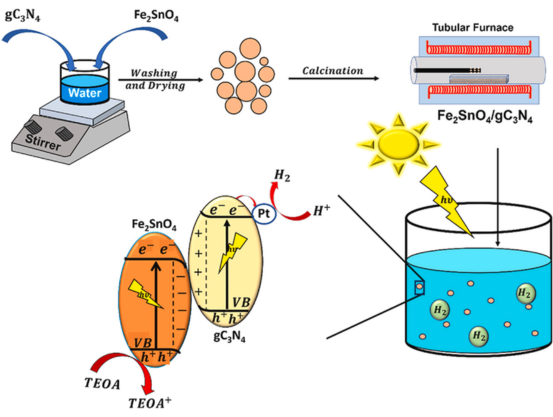
Abstract: This study presents a novel hybrid approach combining heterogeneous catalytic chemical reaction with biological intervention to denitrify wastewater. A graphitic carbon nitride (g-C3N4)-supported Ni-carbon nanofiber (CNF) is used as the catalyst, while Achromobacter denitirificans, isolated from an effluent of a sewage treatment plant, is used as the denitrifying bacteria. g-C3N4 acts as an artificial electron elicitor for biological regulation. Ni enhances the activity of key enzymes which are involved in bacterial denitrification, while the CNF surface immobilizes the bacteria. The catalyst and bacterial cells are characterized and identified using spectroscopic techniques and 16S rRNA sequencing, respectively. The data reveal approximately 99% removal of nitrates from water in 24h at the nitrate concentration of 150 mg/L at the catalyst and bacterial dose of 0.025 g/L and 1% (v/v) with 107 CFU/mL, respectively. Spent water can be recycled and reused. This study provides a new strategy for the denitrification of wastewater.
Read More ...
Abstract: A limited injection of photogenerated electrons in N2 molecules is the core problem limiting the performance of heterojunction materials in photofixing N2 to ammonia. In this study, an inexpensive Sn-based perovskite (NiSnO3, NSO) was anchored over the g-C3N4 (gCN) sheets under mild reaction conditions to develop an S-scheme heterojunction for the photocatalytic nitrogen reduction reaction. The NSO-gCN heterojunction, utilizing methanol as a sacrificial agent, showed remarkable N2 reduction capability with an impressive ammonia evolution of 566 µmolg−1h−1, surpassing that of gCN and NSO by the factor of 3.6 and 40, respectively, in visible light. The significantly improved performance of the material was attributed to the S-scheme charge transfer mechanism. The NSO-gCN photocatalyst showed good stability with only a marginal decrease measured in the activity over 3 cycles of the photocatalytic …
Read More ...
Abstract: The effect of preheating Amberlyst-15 catalyst used for the biodiesel production reaction of Karanja oil was studied. The preheated Amberlyst-15 samples were characterized for their surface area and pore volume and by SEM, TGA and FTIR spectroscopy. A preheat temperature of 473 K was found to optimum. At this temperature, the surface area had increased and the sulfonic acid groups of Amberlyst-15 were retained. At 473 K preheated Amberlyst-15 gradually deactivated with reuse from a biodiesel yield of 85% to 27% in four runs at a reaction temperature of 393 K and methanol to oil ratio of 60:1. For the power-law model, the reaction order was 0.65, the rate constant at 373 K was 0.027 h-1 and activation energy was 86.98 kJ/mol.
Read More ...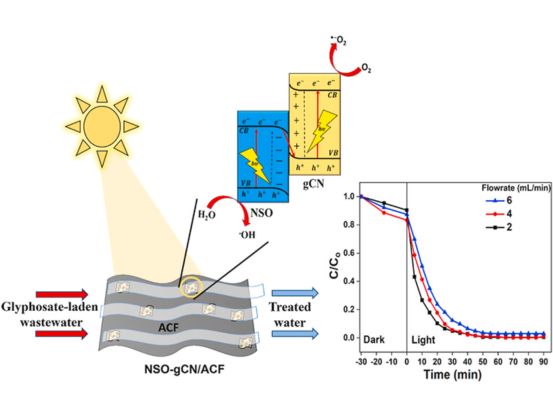
Abstract: A novel heterojunction between Sn-based perovskite and graphitic carbon nitride (gCN) is synthesized to achieve an enhanced spatial charge separation. The interfacial coupling between cube-shaped nickel tin oxide (NSO) and gCN is achieved through the surface sites in NSO. An improved hydrogen production rate of 646 µmol g−1 h−1 is measured in the composite (NSO-gCN), which is twice that in gCN, using triethanolamine (TEOA) and chloroplatinic acid (1% w/w) as holes scavenger and the precursor for the Pt cocatalyst, respectively. Such significant improvement in H2 production performance of the composite is benefited by the high reductive electrons generated via an S-scheme charge transfer pathway, as evidenced by radical trapping experiments and XPS elemental analysis. The composite shows good stability in hydrogen evolution, with marginal (3%) decrease measured in the materials activity after 5 cycles. This study provides an opportunity to develop an S-scheme heterojunction with the Sn-based perovskite anchored in gCN, as an alternative to Ti-based perovskite for various photocatalytic reactions.
Read More ...
Abstract: A proposed economic steady-state process design is developed for valorizing glycerol, a coproduct of biodiesel manufacturing, to glycerol carbonate (GC) via transesterification with dimethyl carbonate (DMC). Methanol is a coproduct of the reaction. The process flowsheet is synthesized using residue curve maps and consists of a pressurized reactive distillation (RD) column followed by three low-pressure simple distillation columns. The sensitivity of the MeOH–DMC azeotrope to pressure is exploited to recover pure MeOH coproduct and recycle the unreacted DMC. Comparison with recently published RD–pervaporation and RD–extractive distillation process designs shows their cost objective to be, respectively, 47 and 20% higher than that of the proposed design. The energy consumption per kmol GC product is also higher by 12 and 26%, respectively. Rigorous dynamic simulations show that the developed process design has good controllability, with a traditional decentralized plant-wide control system effectively handling the principal disturbances with tight product quality control.
Read More ...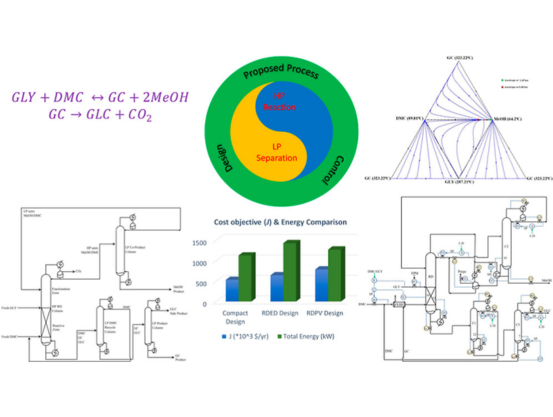
Abstract: A series of Al2O3-supported bimetallic Ni-Fe catalyst with Ni/Fe = 3 are prepared, characterized, and examined for CO2 methanation to identify the total metal loading (Ni+Fe) that yields the maximum activity. The XRD patterns of all catalysts exhibit a noticeable peak shift, which suggests alloy formation and XPS studies reveal that the near-surface concentration of the reduced catalysts possess Ni/Fe ratios similar to those targeted. Analysis of the particle size distribution from TEM and degree of reduction from TPR clearly shows that an increase in metal loading results in a gradual decrease in effective dispersion. However, the catalyst with 55% total metal loading of Ni+Fe, 55Ni3FeAl, possessed the maximum surface metal sites and effective surface metal area, which is reflected in the highest activity of this catalyst during CO2 methanation. Kinetic measurements of the CO2 methanation reaction are obtained on 55Ni3FeAl at temperatures ranging from 513 to 533 K and ambient pressure under differential reactor conditions and in the absence of heat and mass transfer resistance. Several kinetic models are then considered to fit the reaction data for CO2 methanation. The parameters of the models are determined by non-linear regression and analyzed for their thermodynamic consistency and statistical validity (R2, R2adj, NRMSE and F - test). The kinetic data of CO2 methanation on 55Ni3FeAl is adequately represented by a reaction model, where the surface reaction between molecularly adsorbed CO2 and adsorbed H2 appears to be the rate-determining step. The activation energy of this rate determining step was 136 kJ/mol. This kinetic model can then be used to design, analyze, and control different reactors where the most active Al2O3 supported Ni-Fe catalyst with Ni/Fe = 3, 55Ni3FeAl, is used for the CO2 methanation reaction.
Read More ...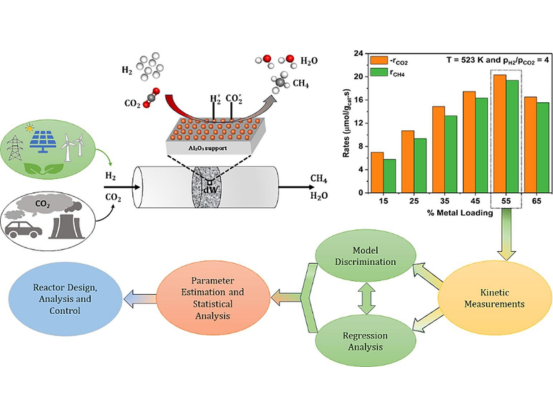
Abstract: Rheological characterization of complex fluids subjected to cyclic shear-rate sweep often exhibits hysteresis. Since both viscoelastic and thixotropic materials show hysteresis loops, it is important to understand distinguishing features (if any) in the same shown by either. Lately, there has been substantial work that attempts to relate the area enclosed by the hysteresis loop with the manner in which shear rate is varied in the cycle, in order to infer thixotropic parameters of a material. In this work, we use the nonlinear Giesekus model to study its response to the application of cyclic shear-rate sweep. We find that this model produces each type of qualitatively similar hysteresis loop that has hitherto been ascribed to thixotropic materials. We also show that the area of the hysteresis loop for a viscoelastic material as a function of sweep rate shows bell-shaped/bi-modal curves as has been observed for thixotropic materials. This study illustrates that caution needs to be exercised while attributing hysteresis loops and associated features observed in a material exclusively to thixotropy. Another feature related to the hysteresis loop is the occurrence of shear banding instability. We find that viscoelastic hysteresis may not have any connection to shear banding instability.
Read More ...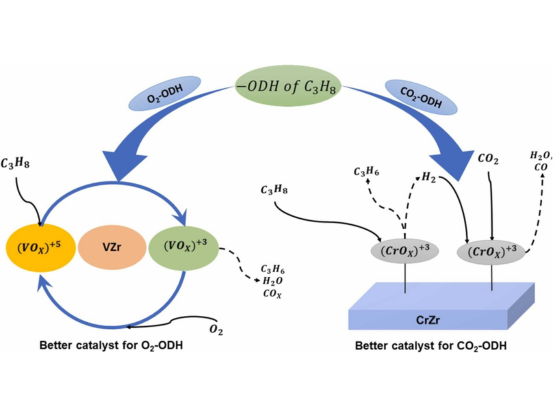
Abstract: Self-propelled droplets serve as ideal model systems to delve deeper into understanding of the motion of biological micro-swimmers by simulating their motility. Biological microorganisms are renowned for showcasing a diverse array of dynamic swimming behaviors when confronted with physical constraints. This study aims to elucidate the impact of physical constraints on swimming characteristics of biological microorganisms. To achieve this, we present observations on the individual and pair-wise behavior of micellar solubilized self-propelled 4-Cyano-4'-pentyl-biphenyl (5CB) oil droplets in a square capillary channel filled with a surfactant trimethyl ammonium bromide (TTAB) aqueous solution. To explore the effect of the underlying Péclet (Pe) number of the swimming droplets, the study is also performed in the presence of additives such as high molecular weight polymer Polyethylene oxide (PEO) and molecular solute glycerol. The capillary confinement restricts droplet to predominantly one-dimensional (1D) motion, albeit with noticeable differences in their motion across the three scenarios. Through a characterization of the chemical and hydrodynamic flow fields surrounding the droplets, we illustrate that the modification of the droplets' chemical field due to confinement varies significantly based on the underlying differences in the Péclet number (Pe) in these cases. This alteration in the chemical field distribution notably affects the individual droplets' motion. Moreover, these distinct chemical field interactions between the droplets also lead to variations in their pair-wise motion, ranging from behaviors like chasing to scattering.
Read More ...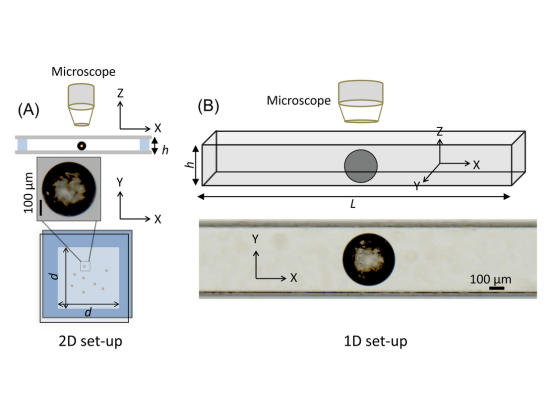
Abstract: Driven by the necessity to achieve a thorough comprehension of the bottom-up fabrication process of functional materials, this experimental study investigates the pairwise interactions or collisions between chemically active SiO2–Pt Janus colloids. These collisions are categorized based on the Janus colloids’ orientations before and after they make physical contact. In addition to the hydrodynamic interactions, the Janus colloids are also known to affect each other’s chemical field, resulting in chemophoretic interactions, which depend on the degree of surface anisotropy in reactivity of Janus colloid and the solute–surface interaction at play. Our study reveals that these interactions lead to a noticeable decrease in particle speed and changes in orientation that correlate with the contact duration and yield different collision types. Distinct configurations of contact during collisions were found, whose mechanisms and likelihood are found to be dependent primarily on the chemical interactions. Such estimates of collision and their characterization in dilute suspensions shall have a key impact in determining the arrangement and time scales of dynamical structures and assemblies of denser suspensions and potentially the functional materials of the future.
Read More ...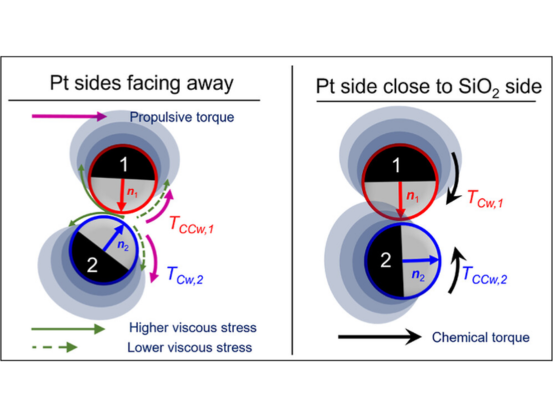
Abstract: While undergoing gelation transition, a material passes through a distinctive state called the critical gel state. In the neighborhood of this critical gel state, how viscosity, equilibrium modulus, and relaxation times evolve are correlated by scaling relations, and their universality has been validated for materials undergoing the sol-gel transition. In this work, we extend this approach for the gel-sol transition of a thermoresponsive polymeric system of aqueous poly(vinyl alcohol) (PVOH) gel that passes through the critical state upon increasing temperature. We observe that, in the neighborhood of the critical gel state, the equilibrium modulus and viscosity demonstrate a power law dependence on the relative distance from the critical state in terms of normalized temperature. Furthermore, the relaxation times in the gel and the sol state shows symmetric power law divergence near the critical state. The corresponding critical power law exponents and the dynamic critical exponents computed at the critical gel-sol transition state validate the scaling and hyperscaling relations originally proposed for the critical sol-gel transition very well. Remarkably, the dependence of complex viscosity on frequency at different temperatures shows a comprehensive master curve irrespective of the temperature ramp rate independently in the gel and the sol state. This observation demonstrates how the shape of relaxation time spectrum is independent of both the temperature as well as the ramp rate. Since sol-gel and the gel-sol transitions are opposite to each other, the applicability of the scaling relations validated in this work suggests broader symmetry associated with how the structure evolves around the critical state irrespective of the direction.
Read More ...
Abstract: Recently remarkably high ionic conductivities (up to 5.5 x 10-3 Ω-1cm−1) at 25 °C have been achieved in sodium superionic conducting (NASICON) solid-state electrolytes via aliovalent cation doping. Doping in NASICON leverages the synergic effects of bottleneck opening (lattice expansion) and correlated migration (higher carrier concentration). However, there is no report published that isolates the effect of correlated migration induced by heterovalent doping without the influence of structural/bottleneck changes. Therefore, here we report for the first time the substitution of trivalent Ru3+ cation into the Zr4+ site to enhance the ionic conductivity of the NASICON electrolyte. Even though Ru3+ has a smaller ionic radius than Zr4+ and leads to bottleneck shrinkage, high ionic conductivity is achieved on doping Ru as compared to undoped NZSP. Using first-principles calculations, we show that even though the bottleneck for Na+ migration shrinks, the diffusion barriers are nearly the same owing to the weaker Na-framework interaction. The doped electrolyte showed an ionic conductivity of 2.1 x 10-3 Ω-1cm−1, an ionic transference number of ∼ 98.9 %, and exhibited stable sodium plating/stripping at 0.5 mA-cm−2 for 100 h with an overpotential of 20 mV owing to the fused microstructure. The assembled all-solid-state battery with Ru-doped electrolyte exhibited an outstanding initial capacity of 87 mAh-g−1 at 0.3C as compared to 70 mAh-g−1 with undoped electrolyte. Compared to the pristine sample, which had capacity retention of 60 % after 100 cycles, the cell containing Ru-doped electrolyte demonstrated stable cycling with an 87 % capacity retention without external pressure.
Read More ...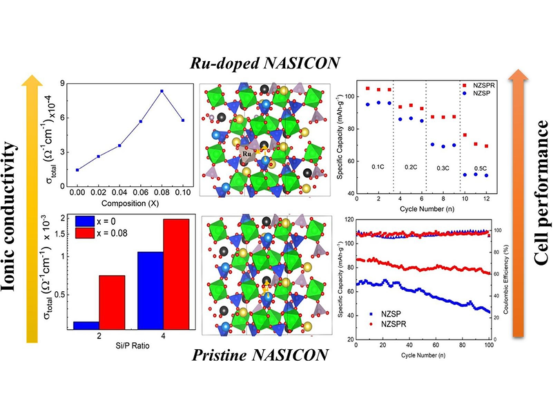
Abstract:The novelty of this study attributes establishing cattle manure as a potent and sustainable green corrosion inhibitor and identifying organic compounds accountable for the same. A simple and convenient maceration method was used for the extraction of a novel, eco-friendly, low-cost, efficient, and water-soluble green corrosion inhibitor from cattle manure. The inhibitor has been characterized through different spectroscopic, spectrometric, and chemical confirmatory tests. The efficacy of the cow manure extract (CME) in mitigating chloride-induced corrosion on mild steel was evaluated through electrochemical impedance and polarization studies at ambient conditions. Electrochemical corrosion monitoring revealed the sustainability of CME as a highly efficient inhibitor from a low-cost agricultural biowaste. Post-corrosion characterizations demonstrated the substantial film-forming characteristics of the CME. Mass spectrometry of the corrosion products assisted in identifying the phytochemicals contributing significantly to the film formation. This study defines an ecological route for agricultural solid waste management.
Read More ...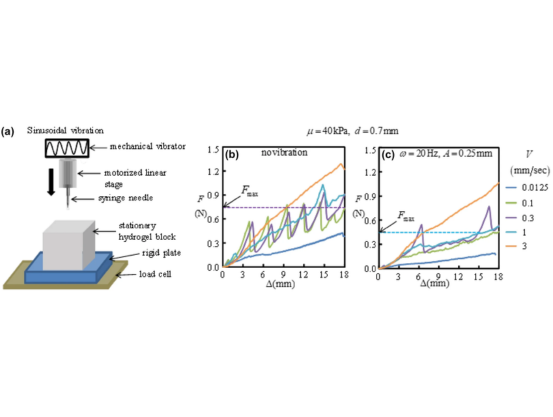
Abstract: Hydroquinone (HQ) is one of the phenolic compounds used a wide range of industrial processes such as in paints, cosmetics, photographic development, antioxidants, and motor fuels/oils. HQ is a drug that can cause cancer and has adverse effects on the central nervous system. Herein, the adsorptive removal of HQ using bagasse fly ash (BFA) and rice husk ash (RHA) as adsorbents is studied. Various parameters are optimized during HQ removal by adsorption. The optimum natural pH (5.3) provided the maximum removal of HQ (HQ-BFA: 94.8% and HQ-RHA: 82.8%). The adsorbent doses for BFA and RHA were 1 and 4 g/L, respectively. The kinetic study revealed that removal by BFA and RHA exhibited first-order kinetics with removal times of 1 and 3 h, respectively. The isothermal equilibrium behavior was studied using Langmuir, Freundlich, and generic XYZ models. Among various isotherms, the XYZ isotherm model best fits the adsorption study data and the Koble-Corrigan parameters are compared as a proof-of-concept. The adsorption of HQ by both adsorbents was endothermic. The thermodynamic study showed that the heat of adsorption was 5.14 and 7.16 kJ/mol, and entropy change was 35.99 and 38.29 J/mol K for BFA and RHA, respectively. The adsorption of HQ in the binary component system was unaffected, while the efficiency of metal ions increased due to synergistic effects in the coexisting system. The present study opens potential avenues for the use of agricultural residues for wastewater treatment.
Read More ...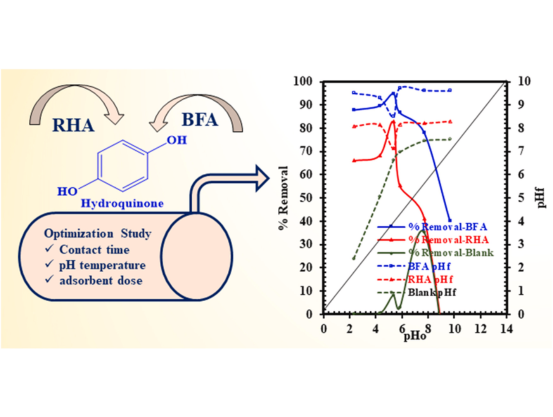
Abstract: Surface modification is an important approach to modify the properties of materials. Numerous approaches have been adopted to tailor the properties of such materials, which have been proven successful at many scales and parameters. However, most of these techniques are often tedious, poorly adhesive, costly, sometimes hazardous, and surface-specific, hence cannot be extended on a large scale and all kinds of surfaces. These shortcomings have led to the emergence of new dopamine (DA) based green surface modification technique where a thin polydopamine (PDA) layer is deposited on surfaces through a facile polymerization of DA under alkaline conditions to enable the surface for various applications. This surface modification strategy has several advantages over other techniques in deposition processing under mild conditions, cost-effective and straightforward ingredients, and applicability to all kinds of surfaces regardless of their sizes, shapes, and types. Moreover, the PDA layer enhances the surface functionality. Therefore, it can serve as a versatile platform for various secondary reactions for a wide range of applications. Herein, the chemistry of DA is summarized and its polymerized form PDA for the modification of different families of materials’ surfaces with an emphasis on energy, environmental and biological applications.
Read More ...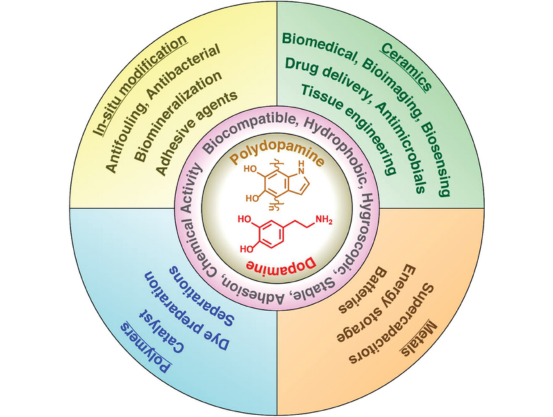
Abstract: The prompt asserts that identifying low levels of vitamin D (hypovitaminosis D) in pregnant women and infants at an early stage is crucial due to the irreversible clinical consequences that can result. The measurement of 25-hydroxy Vitamin D3 levels can serve as a valuable indicator of the risk of developing Vitamin D deficiency. Graphene, a two-dimensional material composed of sp2 hybridized carbon atoms, is highly regarded due to its exceptional thermal, electronic, optical and mechanical properties, as well as its single-atom thickness and large surface area. In this investigation, graphene oxide (GO) were incorporated into paper electrodes, creating a cost-effective material that served as a matrix for developing an immunosensor. Using modified Hummer’s method, graphene oxide was synthesized and subsequently drop-cast onto the surface of a screen-printed paper electrode (SPPE), resulting in enhanced electrochemical signal. Thereafter, SPPE was modified with graphene oxide (GO) and further functionalized with 25-hydroxy Vitamin D3 monoclonal antibody using cross-linking chemistry of EDC:NHS. To characterize the synthesized GO, various analytical techniques were employed, including UV–Vis, FT-IR, Particle Size Analyser, Raman analysis, FE-SEM, TEM and XRD analyses. The stratified modification of the electrode surface was monitored through FT-IR and EIS techniques. Finally, the sensor response was measured after hybridization with different antigen concentrations by CV and DPV analyses. For electrochemical measurements, “K3[Fe (CN)6]3-/4- (5 mM in PBS buffer, pH 7.2)” was utilized as a redox indicator. The developed smart phone android based immunosensor showed a sensitivity of 2036.12µA/mm2/fg and LOD 5.96 fg/µL for electrochemical detection of vitamin D3.
Read More ...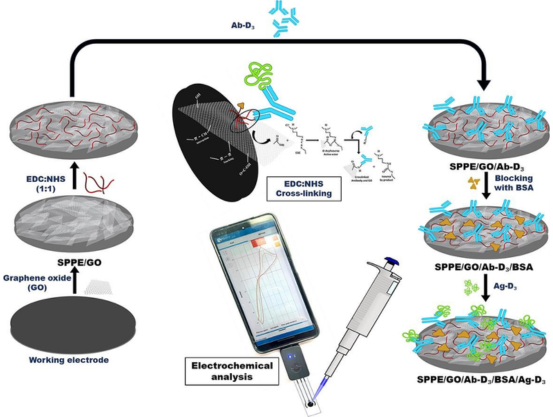
Abstract: The emerging pollutants present in wastewater have become an important scientific and social concern because of their detrimental effect on human health and the ecosystem. To remove these emerging pollutants from wastewater, the conventional methods are insufficient. Therefore, innovative, cost effective, and efficient approaches are required to handle this rising problem. Biomass-based graphene aerogels showed an effective solution for the removal of emerging pollutants from wastewater because of their exceptional properties, such as large surface area, tunable pore structures, and high adsorption capacity, which make them highly efficient for the removal of a wide range of pollutants. This review article provides a detailed overview of the synthesis techniques of graphene aerogels and highlights the influence of fabrication parameters on the performance of the resulting aerogels. Furthermore, this review discusses emerging pollutants and their classification in detail along with detection of emerging pollutants using graphene aerogels. This review further explores the application potential of biomass-based graphene aerogels in wastewater treatment, such as adsorbents, photocatalysts, graphene aerogel-based membranes, etc. emphasizing their capability to remove diverse classes of emerging pollutants. Finally, the conclusion and future prospects in the development and application of biomass-based graphene aerogels for the removal of emerging pollutants from wastewater are discussed. This review underscores the need for further research to optimize the synthesis processes, enhance the adsorption capacity, and evaluate the long-term performance of graphene aerogels in real-world wastewater treatment scenarios.
Read More ...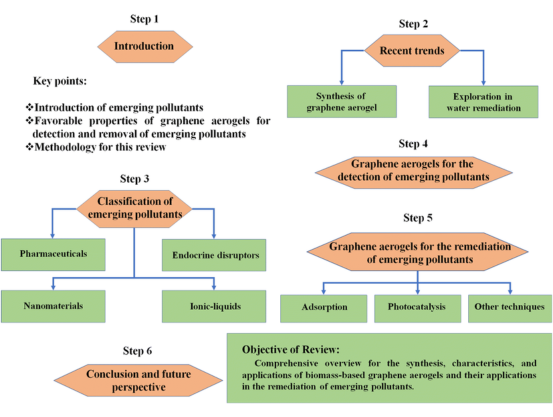
Abstract: Alzheimer's disease (AD), the most common form of dementia, is closely related to the overproduction of reactive oxygen species (ROS). A kinetic model based on free radical polymerization of amyloid beta (Aβ) utilizing ROS as an initiator is proposed. Kinetic parameters involved in the model are tuned with the reported experimental data on fibril molecular weight. The tuned model is used to simulate time evolution of fibril length and polydispersity of Aβ aggregates. The simulated values are compared with the reported experimental values for these fibril properties. A good agreement is observed between the model simulated fibril properties and the reported experimental data. This supports the hypothesis of ROS as the cause of Aβ aggregation using the free radical polymerization. The proposed model is also able to predict the sigmoidal growth of fibrils at different set of parameter values. Sensitivity analysis has been performed to check the reliability of the proposed model. It is envisaged that the proposed model will be helpful to elucidate ROS-based therapeutic strategies for AD treatment in near future.
Read More ...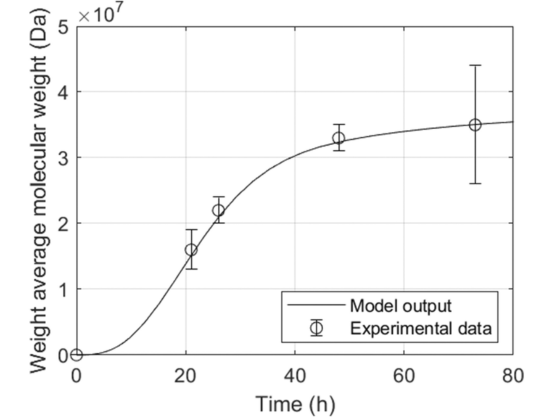
Abstract: Considering the virtue of the environment, the usage of biofuel blended fossil fuels for transportation has speeded across the globe. The quality of biodiesel plays an important role in the efficiency of a diesel engine. The biodiesel by transesterification method produces crude biodiesel. The crude biodiesel contains impurities like glycerol, alcohol, catalyst, and water molecules that are suspended in the Fatty Acid Methyl Ester (FAME) molecule. These impurities in the crude biodiesel affect the performance of the engine with improper spray pattern, corrosion, nozzle blockage, affecting autoignition temperature and increase the NOx emission in exhaust gas. The shelf life of the stored biodiesel also gets affected by these left-over impurities. In order to overcome and refine it, a novel filtration of crude biodiesel using reverse osmosis membrane has been discussed. ANSYS Finite Element Analysis has been carried out for this investigation. Pressure in an increasing sequence of 100 kPa to 1500 kPa has been varied for the analysis of this multiphase flow through porous medium. The changes in velocity, pressure, density, and viscosity have been observed through the obtained contours. The results include the variation of velocity, density, and viscosity with reference to pressure. The study also indicated that the minimum pressure required for the filtration is 500 kPa. Further, the increase in viscosity and density after the filtration zone, represents the increase in the volume fraction of the impurities.
Read More ...
Abstract: Solitons in nematic liquid crystals facilitate the rapid transport and sensing in microfluidic systems. Little is known about the elementary conditions needed to create solitons in nematic materials. In this study, we apply a combination of theory, computational simulations, and experiments to examine the formation and propagation of solitary waves, or ”solitons”, in nematic liquid crystals under the influence of an alternating current (AC) electric field. We find that these solitary waves exhibit “butterfly”-like or “bullet”-like structures that travel in the direction perpendicular to the applied electric field. Such structures propagate over long distances without losing their initial shape. The theoretical framework adopted here helps identify several key factors leading to the formation of solitons in the absence of electrostatic interactions. These factors include surface irregularities, flexoelectric polarization, unequal elastic constants, and negative anisotropic dielectric permittivity. The results of simulations are shown to be in good agreement with our own experimental observations, serving to establish the validity of the theoretical concepts and ideas advanced in this work.
Read More ...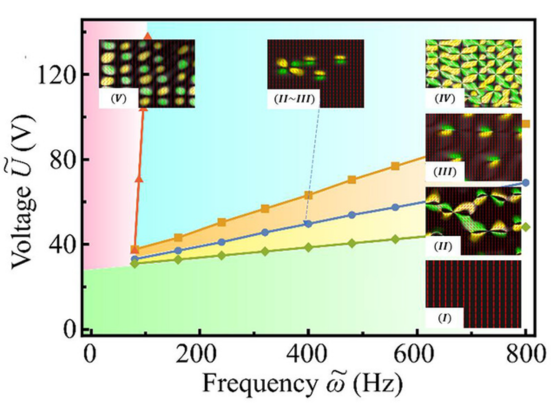
Abstract: Hydrodesulfurization (HDS) reaction activity depends on the formation of active NiMoS (completely sulfided multilayer type 2 sites) and inactive NiAl2O4/NixSy phases on the catalyst surface. These inactive phases not only itself inactive for the reaction but also hinder the formation of active NiMoS phases. In addition, the formation of strong Mo-O-Al bonds also lowers the reducibility of the catalyst, suggesting lesser catalytic activity (type 1 sites, partially sulfided single-layer sites). To this end, we report the formation of NiMo/Ga doped amorphous alumina (A-Al2O3) catalysts prepared by the colloidal synthesis method. A-Al2O3 was chosen as a support because it has lower surface energy, better physicochemical properties, and enhanced acidic sites than the crystalline alumina phase, which favours the formation of type 2 sites or weak metal-support interaction (completely sulfided multilayer NiMoS sites). Further, the Ga doping in A-Al2O3 support substitute the tetrahedral Al sites and form GaAl2O4 phases by reducing NiAl2O4 inactive sites, and the free Ni decorate the edges of MoS2 to form HDS active NiMoS sites. Therefore, NiMo/Ga doped A-Al2O3 catalyst (at 1 wt% Ga loading) reported enhanced HDS catalytic activity (25%), HDS reaction rate constant (kHDS-2.15 times) and turn over frequency (TOF-1.3 times) than the conventional NiMo/γ-Al2O3 catalysts.
Read More ...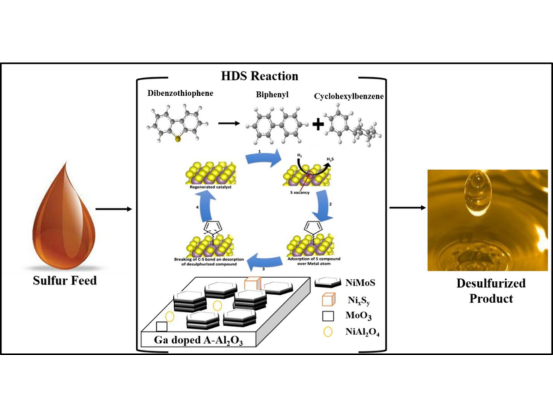
Abstract: Polydimethylsiloxane (PDMS) is known to be a common substrate for various cell culture-based applications. However, native PDMS is not very conducive for cell culture and hence, surface modification via cell adhesion moieties is generally needed to make it suitable especially for long-term cell culture. To address this issue, we propose to coat PDMS nanoparticles (NPs) on the surface of PDMS film to improve adhesion, proliferation and differentiation of skin cells. The proposed modification strategy introduces necessary nanotopography without altering the surface chemical properties of PDMS. Due to resemblance in the mechanical properties of PDMS with skin, PDMS NPs can recreate the native extracellular nanoenvironment of skin on the PDMS surface and provide anchoring sites for skin cells to adhere and grow. Human keratinocytes, representing 95% of the epidermal skin cells maintained their characteristic well-spread morphology with the formation of interconnected cell-sheets on this coated PDMS surface. Moreover, our in vitro immunofluorescence studies confirmed expression of distinctive epidermal protein markers on the coated surface indicating close resemblance with the native skin epidermis. Conclusively, our findings suggest that introducing nanotopography via PDMS NPs can be an effective strategy for emulating the native cellular functions of keratinocytes on PDMS based cell culture devices.
Read More ...
Abstract: Protein misfolding and its aggregation, known as amyloid aggregates (Aβ), are some of the major causes of more than 20 diseases such as Parkinson's disease, Alzheimer's disease, and type 2 diabetes. The process of Aβ formation involves an energy-driven oligomerization of Aβ monomers, leading to polymerization and eventual aggregation into fibrils. Aβ fibrils exhibit multilevel chirality arising from its amino acid residues and the arrangement of folded polypeptide chains; thus, a chirality-driven approach can be utilized for the detection and inhibition of Aβ fibrils. In this regard, chiral nanomaterials have recently opened new possibilities for various biomedical applications owing to their stereoselective interaction with biological systems. Leveraging this chirality-driven approach with chiral nanomaterials against protein-aggregated diseases could yield promising results, particularly in the early detection of Aβ forms and the inhibition of Aβ aggregate formation via specific and strong “chiral–chiral interaction.” Despite the advantages, the development of advanced theranostic systems using chiral nanomaterials against protein-aggregated diseases has received limited attention so far because of considerably limited formulations for chiral nanomaterials and lack of information of their chiroptical behavior. This review aims to present the current status of chiral nanomaterials explored for detecting and inhibiting Aβ forms. This review covers the origin of chirality in amyloid fibrils and nanomaterials and different chiral detection methods; furthermore, different chiral nanosystems such as chiral plasmonic nanomaterials, chiral carbon-based nanomaterials, and chiral nanosurfaces, which have been used so far for different therapeutic applications against protein-aggregated diseases, are discussed in detail. The findings from this review may pave the way for the development of novel approaches using chiral nanomaterials to combat diseases resulting from protein misfolding and can further be extended to other disease forms.
Read More ...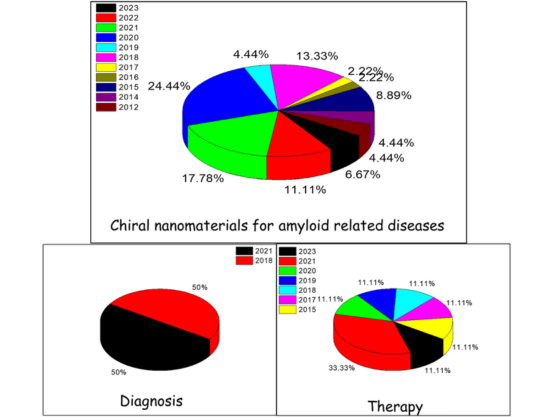
Abstract: Recently remarkably high ionic conductivities (up to 5.5 x 10-3 Ω-1cm−1) at 25 °C have been achieved in sodium superionic conducting (NASICON) solid-state electrolytes via aliovalent cation doping. Doping in NASICON leverages the synergic effects of bottleneck opening (lattice expansion) and correlated migration (higher carrier concentration). However, there is no report published that isolates the effect of correlated migration induced by heterovalent doping without the influence of structural/bottleneck changes. Therefore, here we report for the first time the substitution of trivalent Ru3+ cation into the Zr4+ site to enhance the ionic conductivity of the NASICON electrolyte. Even though Ru3+ has a smaller ionic radius than Zr4+ and leads to bottleneck shrinkage, high ionic conductivity is achieved on doping Ru as compared to undoped NZSP. Using first-principles calculations, we show that even though the bottleneck for Na+ migration shrinks, the diffusion barriers are nearly the same owing to the weaker Na-framework interaction. The doped electrolyte showed an ionic conductivity of 2.1 x 10-3 Ω-1cm−1, an ionic transference number of ∼ 98.9 %, and exhibited stable sodium plating/stripping at 0.5 mA-cm−2 for 100 h with an overpotential of 20 mV owing to the fused microstructure. The assembled all-solid-state battery with Ru-doped electrolyte exhibited an outstanding initial capacity of 87 mAh-g−1 at 0.3C as compared to 70 mAh-g−1 with undoped electrolyte. Compared to the pristine sample, which had capacity retention of 60 % after 100 cycles, the cell containing Ru-doped electrolyte demonstrated stable cycling with an 87 % capacity retention without external pressure.
Read More ...
Abstract:We used quantum chemical calculations to examine methane pyrolysis catalyzed by molten sodium. Such a reaction is performed in a bubble column filled with a molten catalyst. The ascending bubble contains methane and sodium vapor, where the reaction takes place. Therefore, the reaction is catalyzed by the liquid surface of the bubble, by the sodium vapor in the bubble, and in the headspace above the melt. We examined the rate of 24 possible reactions in the gas and concluded that gas-phase pyrolysis is ineffective. On the other hand, the liquid surface is as good a pyrolysis catalyst as any of the melts studied so far.
Read More ...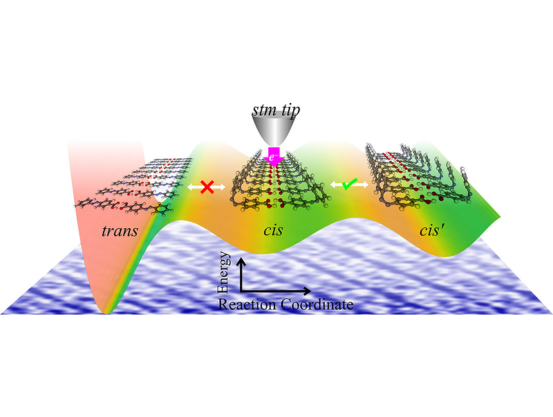
Abstract:Supported molybdenum oxides have been widely employed as catalysts for variety of reactions including upgrading of bio-oil via hydrodeoxygenation. Herein, we perform spin-polarized density functional theory calculations to investigate the structures and reactivity of monomeric MoO species supported on ZrO in the absence and presence of hydroxyl(s). Monomeric molybdenum moieties were found to have a mono-oxo (one molybdenyl), di-oxo (two molybdenyls) or a pero-oxo (one molybdenyl and Mo coordinated to a peroxide) configuration. Based on the formation energies, we find that mono-oxo moieties are the most stable among the three. This is also true for the moieties in the presence of hydroxyls on the support. Further, the computed vibrational frequencies of a mono-oxo moiety on a hydroxylated support is a closer match to the peaks observed in experiments. A thermodynamic analysis of the molybdenum oxide moieties on a hydroxylated support indicated that the dehydroxylation is favoured at high temperatures and low partial pressures of water. On adsorption of hydrogen on the oxygen of the support, hydrogen loses its electron and reduces Mo of the monomeric moiety without making an oxygen vacancy. We studied the activity of this reduced site for deoxygenation of anisole to benzene. The overall barriers for this reaction are comparable to previously computed barriers for deoxygenation of bio-oil model compounds on an oxygen-vacant molybdenum oxide surfaces, suggesting that this may be an important mechanistic pathway during a hydro-deoxygenation process.
Read More ...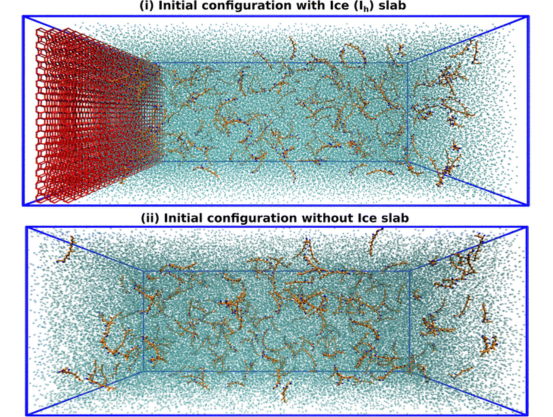
Abstract:A melt containing 1% FeCl3 and 99% KCl is a good catalyst for methane pyrolysis, while molten KCl has almost no catalytic activity. We use ab initio molecular dynamics, based on density functional theory, to examine why this surprising behavior takes place. We find that in this ionic salt, the charge on the iron fluctuates between Fe3+ and Fe2+, and the conversion to Fe2+ takes charge from several chlorine ions, which become active for methane dissociation. We speculate that such activation is general and takes place for any dopant Mn+, which has a state M(n–1)+.
Read More ...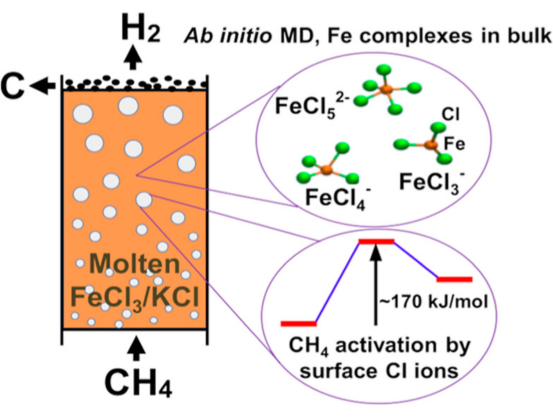
Abstract:We analyze the linear stability of viscoelastic channel flows, with velocity profiles that are asymmetric about the channel centerline, belonging to the one-parameter Couette-Poiseuille family (CPF). These flows are driven by a combination of an imposed pressure gradient and (tangential) wall motion. A particular member of this family, corresponding to a zero net volumetric flux, may be experimentally realized in a shallow lid-driven cavity flow configuration, as well as in the narrow-gap limit of the Taylor-Couette geometry with an obstruction at a fixed azimuthal angle (a narrow gap Taylor-Dean flow). Recent work by Khalid et al.[Phys. Rev. Lett. 127, 134502 (2021)] has shown, using the Oldroyd-B model, that plane Poiseuille flow with a symmetric velocity profile becomes unstable, even in the absence of inertia, to an elastic “center mode” with phase speed close to the base-state maximum. In contrast, viscoelastic …
Read More ...
Abstract:Harmonic balance (HB) is a popular Fourier-Galerkin method used in the analysis of nonlinear vibration problems where dynamical systems are subjected to periodic forcing. We adapt HB to find the periodic steady-state response of nonlinear differential constitutive models subjected to large amplitude oscillatory shear flow. By incorporating the alternating-frequency-time scheme into HB, we develop a computer program called FLASH (acronym for Fast Large Amplitude Simulation using Harmonic balance), which makes it convenient to apply HB to any differential constitutive model. We validate FLASH by considering two representative constitutive models, viz., the exponential Phan-Thien Tanner model and a nonlinear temporary network model. In terms of accuracy and speed, FLASH outperforms the conventional approach of solving initial value problems by numerical integration via time-stepping methods often by several orders of magnitude. We discuss how FLASH can be conveniently extended for other nonlinear constitutive models, which opens up potential applications in model calibration and selection, and stability analysis.
Read More ...
Abstract:A thixotropic colloidal gel constituting an aqueous dispersion of synthetic clay Laponite with varying concentrations of salt has been studied for its rheological and tribological performance as a lubricant. We observed that the incorporation of NaCl induces notable enhancements in the colloidal gel’s relaxation time, elastic modulus, and yield stress. Although an increase in NaCl concentration decreases the material’s relaxation time dependence on waiting time (tw), overall, the strength of its thixotropic character has been observed to increase with an increase in salt concentration. The analysis of friction and wear indicated that the utilization of a thixotropic colloidal gel of Laponite with a higher concentration of NaCl resulted in progressively greater reductions in both the coefficient of friction and specific wear rates under various load-speed conditions. Severe abrasive wear on disc surface under dry test, gradually mitigated upon the introduction of these lubricants. Two simultaneous lubricating mechanisms, first, the smooth sliding of the friction pair, facilitated by the alignment of Laponite particles in the direction of shear forces, and second, the stable structure of Laponite, coupled with the addition of NaCl, enabling continuous replenishment of the wear track with lubricant, are attributed to lubrication effectiveness.
Read More ...
Abstract:We consider the corotational Maxwell model which is perhaps the simplest constitutive model with a nontrivial oscillatory shear response that can be solved analytically. The exact solution takes the form of an infinite series. Due to exponential convergence, accurate analytical approximations to the exact solution can be obtained by truncating the series after a modest number (10–20) of terms. We compare the speed and accuracy of this truncated analytical solution (AS) with a fast numerical method called harmonic balance (HB). HB represents the periodic steady-state solution using a Fourier series ansatz. Due to the linearity of the constitutive model, HB leads to a tridiagonal linear system of equations in the Fourier coefficients that can be solved very efficiently. Surprisingly, we find that the convergence properties of HB are superior to AS. In terms of computational cost, HB is about 200 times cheaper than AS. Thus, the answer to the question posed in the title is affirmative.
Read More ...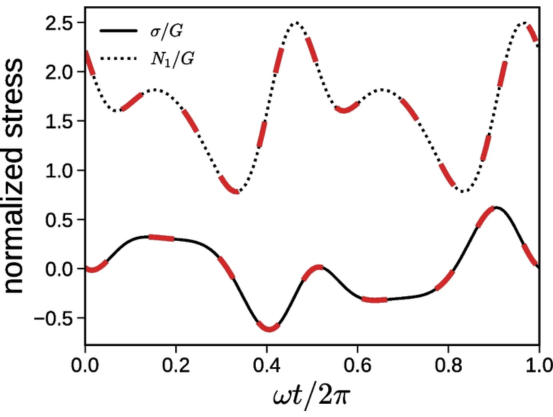
Abstract:Carrageenans comprise linear sulfated high molecular weight polysaccharides obtained from seaweeds and are routinely used in food and home/personal care industries. Various kinds of carrageenans differ from others based on the ester sulphate group location on the polysaccharide chains. Pure and mixed systems of Kappa Carrageenan and Iota Carrageenan undergo a three-dimensional gel network structure formation or dissociation with a change in temperature. During the sol-gel and gel-sol transitions, the Carrageenan systems pass through a unique critical gel state, where dynamic moduli are scale-invariant owing to the self-similar structure of the three-dimensional network. In this work, we obtain the critical gel state associated with pure and mixed systems of Kappa and Iota Carrageenan during cooling and heating by exploring the material behavior for a range of frequencies. Interestingly, on the one hand, the mixed gels show a higher critical sol-gel transition temperature compared to the pure systems at equal individual concentrations. On the other hand, the low temperature moduli of mixed gels are closer to that of Kappa Carrageenan when the concentration of the same is more than half in the mixture. The rheological measurements demonstrate that the Kappa Carrageenan strongly affects the nature of aggregation of double helices of Iota Carrageenan, but Iota Carrageenan does not have a significant influence on that of Kappa Carrageenan. These results suggest an associative, interactive network formation between Kappa and Iota Carrageenan in the mixture, such that the gel behavior is predominantly influenced by Kappa Carrageenan.
Read More ...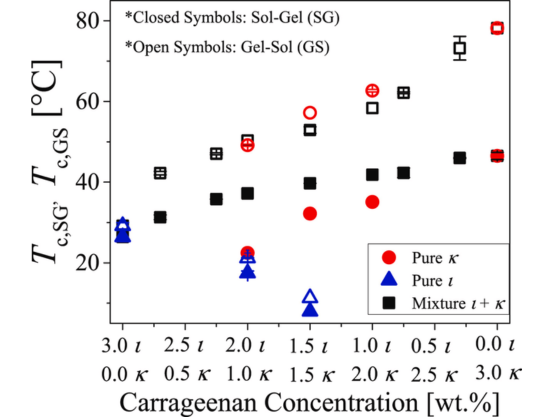
Abstract:We examined the effect of deformability of a solid substrate on the kinetics of a surface reaction that occurs between chemical species present in it and a liquid dispensed on it. In particular, we have dispensed aqueous solutions of gold and silver salt as sessile drops or as a liquid pool on a cross-linked film of poly(dimethylsiloxane) (PDMS). The PDMS surface contains organosilane (SiH), which reduces the salt, producing metallic nanoparticles at the solid–liquid interface. These experiments reveal that, for a sufficiently soft solid, the reaction proceeds about three times faster in the drop mode than in the pool mode. The reaction conditions in both cases remain exactly identical except that, for the drop, the vertical component of the liquid surface tension deforms the solid substrate at the three-phase contact line. We have estimated the solid–liquid and solid–air interfacial energy, which along with the surface energy of the liquid gives an estimate of excess free energy. This energy is found to be different for the drop and pool modes. By considering that this excess free energy decreases the activation energy barrier for the reaction, we have shown that the reaction rate constant in the drop mode should indeed exceed that in the pool mode by about three times.
Read More ...